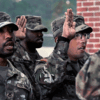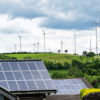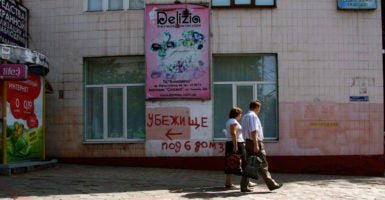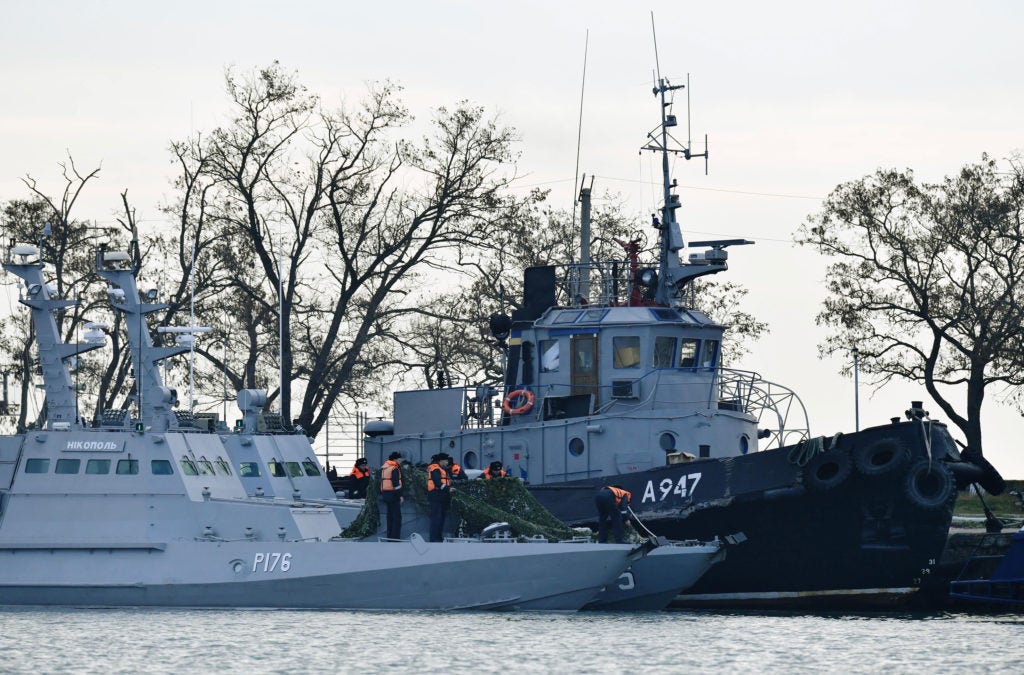KYIV, Ukraine—Sunday’s Kerch Strait crisis underscored how quickly Russia’s simmering, 4.5-year-old, low-intensity war against Ukraine could escalate into a historic catastrophe.
“Yesterday we were close to war. In fact, war happened,” Capt. Andrii Ryzhenko, the Ukrainian navy’s deputy chief of staff for Euro-Atlantic integration, told The Daily Signal on Monday.
On Sunday, Russian ships fired on and captured three Ukrainian navy vessels approaching the Kerch Strait, a narrow waterway that connects the Black Sea to the Sea of Azov. The three Ukrainian vessels, two artillery boats and a tugboat, were in transit from Odesa to the Ukrainian port of Mariupol on the Sea of Azov.
Russian forces reportedly took 24 Ukrainian crew members prisoner during the maritime confrontation. Russia has already tried some of the captured Ukrainians as criminals. Kyiv, however, says the crews should be designated as prisoners of war, subject to the Geneva Conventions.
As of Wednesday, Ukraine’s armed forces remain on full alert. Martial law went into effect on Wednesday morning in 10 Ukrainian regions bordering Russian territory, as well as along the country’s Black Sea and Azov Sea coastlines. Ukrainian regions bordering the breakaway territory of Transnistria in Moldova, where Russia has stationed troops, are also under martial law.
The martial law status is scheduled to last for 30 days, Kyiv says.
Russia, for its part, announced on Wednesday the deployment of additional, advanced S-400 surface-to-air missiles to Crimea, a peninsula that Russia invaded and seized from Ukraine in 2014.
Russia already has three S-400 units deployed and activated in Crimea, according to Russian news reports. Thus, the entirety of Ukraine’s Black Sea and Sea of Azov coastlines remains under the shadow of Russian surface-to-air missiles—a lethal prospect for Ukraine’s air force.
Ukrainian President Petro Poroshenko, meanwhile, has been on a media blitz since Sunday, warning that an ongoing Russian military buildup on Ukraine’s borders could be a precursor to invasion.
“After the incident in the Azov Sea, we had to provide for the Ukrainian armed forces to repel a large-scale ground invasion,” Poroshenko tweeted Wednesday. “I want no one to think that this is fun and games. The country is under threat of a full-scale war with the Russian Federation.”
During a Tuesday roundtable with a trio of Ukrainian journalists, Poroshenko unveiled a binder of aerial photographs he said were provided by Ukrainian intelligence units. The photos were evidence, the Ukrainian president said, that since Sept. 17 Russia has tripled the number of tanks at a military base only 18 kilometers (11 miles) from the Ukrainian border, underscoring a broader buildup of Russian forces within striking distance of Ukraine.
“The number of [Russian] units re-deployed along the entire length of our border has dramatically increased,” Poroshenko said.
On Wednesday in Mariupol—a Ukrainian port city of 500,000 people on the Sea of Azov—life was reportedly going on as normal, with no visible markers of either the enacted martial law or the military mobilization.
“Everything is as before, as if nothing happened,” Alexey Kelt, a 23- year-old Ukrainian combat veteran who lives in Mariupol told The Daily Signal.
Shattered Status Quo
Russia invaded Ukraine four and a half years ago, and the two erstwhile Soviet allies have been at war—albeit a limited, geographically quarantined one—ever since.
More than 10,300 Ukrainians have so far died in the conflict and on average one Ukrainian soldier still dies in combat every three days. The conflict is Europe’s only ongoing land war.
Since a shaky cease-fire, known as Minsk II, quelled the fighting in February 2015, the physical effects of the war have remained more or less geographically quarantined along a 250-mile-long static and entrenched front line in Ukraine’s embattled southeastern Donbas region. For the most part, the war has been fought from trenches and without the concurrent use of air or maritime forces.
Sunday’s seaborne confrontation, however, shattered the status quo military stalemate between Russia and Ukraine.
For one, it adds a maritime front to the ongoing trench war. It also marks the first time in four and a half years of constant combat that Russia has openly admitted to firing on Ukrainians.
“In fact, what happened on Nov. 25 is an extraordinary event,” Poroshenko said Tuesday.
“For the first time in four and a half years of Russian aggression, officially, without tearing off chevrons, without ‘little green men,’ Russian troops in large numbers attacked the ships of the armed forces of Ukraine,” Poroshenko said.
Martial Law
According to some Ukrainian officials, the martial law that went into effect in parts of Ukraine on Wednesday was designed to cut down on the mobilization and deployment times required by Ukraine’s combined armed forces to defend against a Russian invasion.
Ukraine’s national security doctrine is a mix of conventional military force with the use of irregular, civilian territorial defense forces. Those irregular forces are meant to wage a guerilla war behind the front lines of an enemy invasion.
Thus, officials say that declaring martial law in those regions most vulnerable to a Russian attack puts Ukraine on a fast-tracked war footing now that Russia has signaled its intent to escalate the conflict.
“We already have an escalation and martial law is an opportunity to test the different systems of personnel management to find out our weaknesses and to improve them in case of further [Russian] escalation,” Alex Ryabchyn, a Ukrainian member of parliament, told The Daily Signal.
Echoing that line of thinking, on Wednesday Poroshenko tweeted his rationale for martial law in the context of military readiness: “We should not lose any moment in the event of open, full-scale ground aggression. Use everything: from mobilization to the operation of the territorial defense headquarters. Protecting people is our primary goal. Do not allow the aggressor to break through even farther.”
Thus, with Ukraine’s military—both its regular and irregular units—poised for war, some fear there is little breathing room in the current standoff to absorb another unforeseen crisis without it leading to catastrophe. A miscalculation by either side could spark an uncontrollable chain reaction leading to a general war, especially as the rhetoric between Kyiv and Moscow heats up.
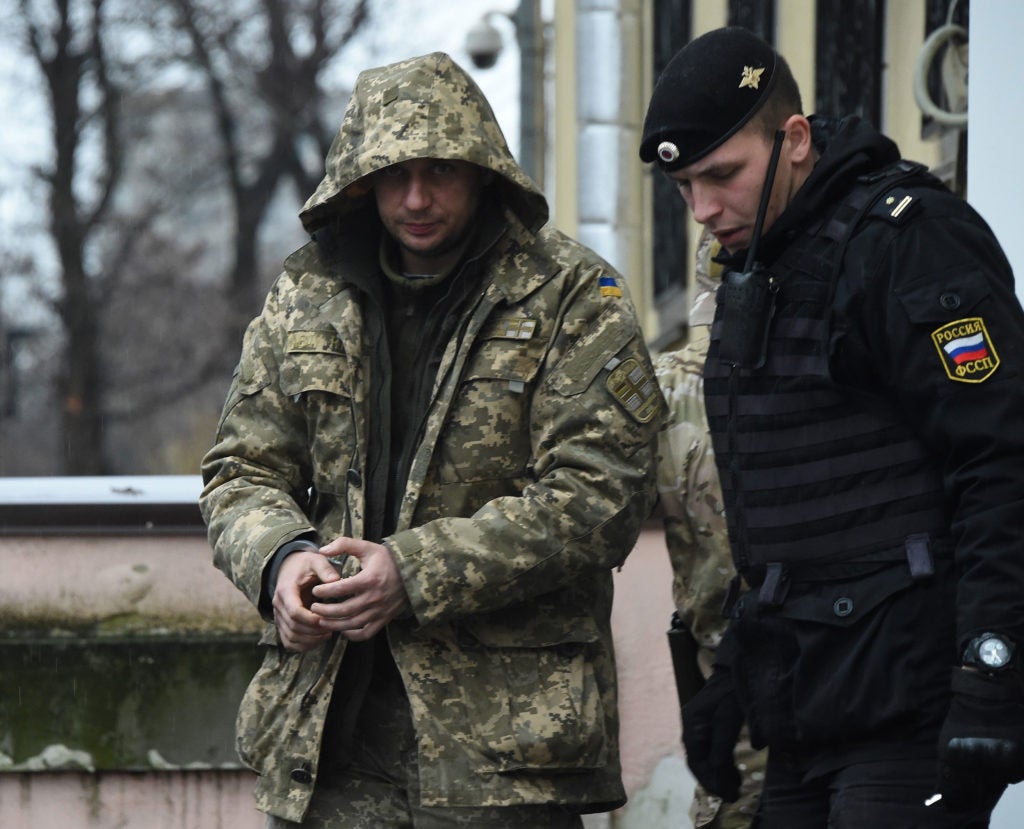
Vladimir Lesovoy, a sailor of one of the three Ukrainian ships that were seized by the Federal Security Service of Russia on Nov. 25 in the Kerch Strait, is accused of illegal Russian border crossing, Nov. 28, 2018. (Photo: Viktor Korotaev/Kommersant Photo/Polaris/Newscom)
“Further escalation of the situation by the Russian Federation should not be ruled out,” Volodymyr Yelchenko, Ukraine’s permanent representative to the United Nations, said at a Monday meeting of the U.N. Security Council.
“According to available intelligence data, there is a clear threat for the invasion and seizing of Mariupol and Berdyansk,” Yelchenko said.
Sunday’s maritime confrontation at the Kerch Strait was a chilling reminder for many Ukrainians of the spring and summer of 2014, when the war with Russia began and the possibility of a full-scale invasion hung over the country like a sword of Damocles.
As evidence of that volatile period, in cities across Ukraine, including the capital city of Kyiv, there are still spray-painted signs on the sides of many buildings pointing to the nearest bomb shelter.
“The situation in Azov Sea has reminded me of the same feeling during the scary days in 2014 in the Donbas. I was refreshing every five seconds the news tabs and Twitter trying to find new information about our sailors and our ships,” said Ryabchyn, the Ukrainian member of parliament.
“But this was the first official attack, not like in 2014 with the little green men without insignia in Crimea, or the so-called separatists,” Ryabchyn added, referring to the patchless Russian soldiers who invaded Crimea in 2014, as well as Russia’s proxy forces in eastern Ukraine.
A New Front
The Kerch Strait divides mainland Russia from the Crimean Peninsula, which Russia invaded and seized from Ukraine in 2014. The narrow maritime passage is the only outlet to the Sea of Azov, where Ukraine has two major ports.
This summer, Russian naval forces stepped up their harassment of Ukrainian merchant vessels in the Sea of Azov, spurring Kyiv to respond.
Along the Sea of Azov coastline, Ukraine has built a network of coastal defenses, including the creation of a new Marine brigade, as well as a new naval base at the port of Berdyansk on the Sea of Azov.
Russia’s 2014 takeover of Ukraine’s Crimean Peninsula left 80 percent of Ukraine’s navy in the Kremlin’s hands. Rather than replace the blue-water warships lost in Crimea, however, Ukrainian military leaders have prioritized the creation of a “mosquito fleet” of shallow-water craft armed with advanced anti-ship weapons.
To that end, in September the U.S. Coast Guard handed over two of its decommissioned 110-foot armed cutters to Ukraine.
On Sept. 23, two Ukrainian navy vessels effectively ran Russia’s de facto blockade of the Sea of Azov. On that day, as Russian warplanes reportedly buzzed overhead, Russian ships escorted the two Ukrainian naval vessels, the Donbas and the Korets, as they passed through the Kerch Strait, Ukraine’s navy reported at the time.
Once through, the two Ukrainian navy ships were met by a pair of armored Ukrainian Gyurza-M class gunboats in the Sea of Azov, which served as escorts as the four vessels steamed toward the Ukrainian port of Mariupol, arriving there safely on Sept. 25.
The exercise underscored the burgeoning crisis between Russia and Ukraine over the right of free movement through the Kerch Strait into the Sea of Azov.
Now, many Ukrainian officials and experts fear that Sunday’s maritime confrontation at the Kerch Strait could be the opening salvo of a stepped-up Russian gambit to consolidate its control over the entire Sea of Azov basin.
“Russian domination at the Sea of Azov could help to create so-called land corridor to Crimea. This is why Russia uses the boa constrictor strategy at sea,” Ihor Kabanenko, a retired Ukrainian navy admiral, told The Daily Signal.
“Ukraine needs naval forces in the Azov [Sea] to prevent the worst land scenario and to protect its economic interests by using maritime lines,” added Kabanenko, who also formerly served as military representative of Ukraine to NATO, chief of operations of the Ukrainian armed forces, and Ukraine’s deputy chief of defense.
Clear Threat
Since 2014, Ukraine’s Crimean Peninsula has become a Russian military redoubt.
From October 2014 (eight months after Russia’s seizure of Crimea) to October 2018, the number of Russian troops in Crimea tripled, Poroshenko said on Tuesday, adding that Russia has also increased its stockpiles of armored personnel carriers, artillery systems, multiple-launch rocket systems, and has deployed more warplanes and ships to the peninsula.
“The buildup is still underway now,” Poroshenko said
“Crimea today continues to play the most important role in maintaining the country’s military security,” Russian Defense Minister Sergei Shoigu said in June, the Russian news site TASS reported.
“In the peninsula there has been created a unique combined force and it is being strengthened steadily. Its advanced high-tech weapon systems will leave no chance for a potential enemy that may dare attack this indigenous Russian land,” Shoigu reportedly said.
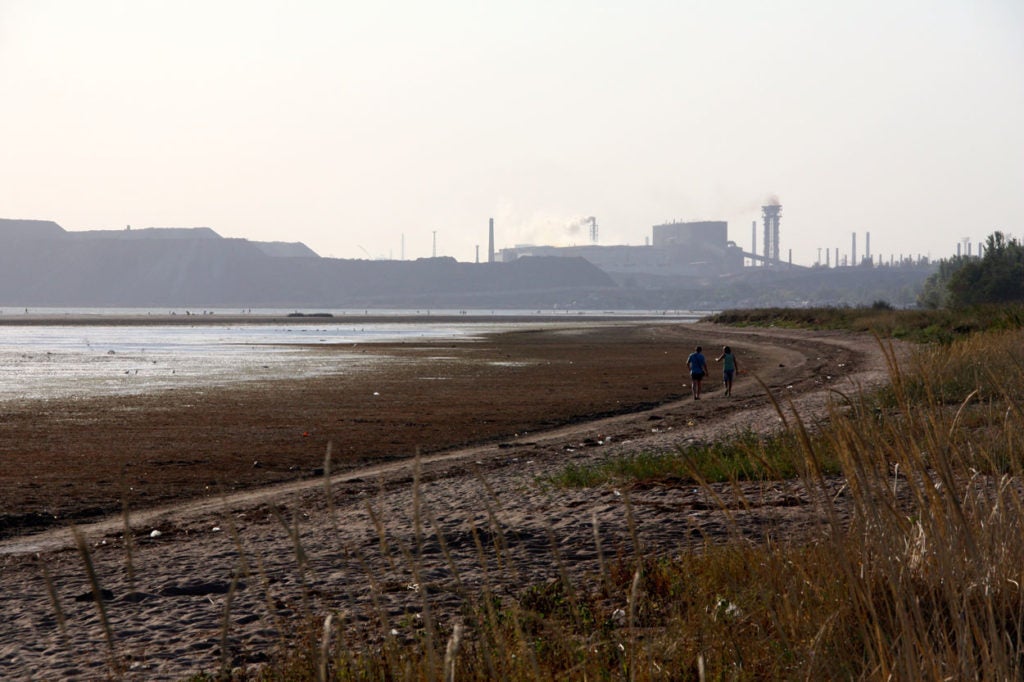
The shoreline in Mariupol, a key Ukrainian port city on the Sea of Azov. (Photo: Nolan Peterson/The Daily Signal)
Beyond Crimea, Russia has positioned about 77,000 troops on Ukraine’s borders capable of launching a rapid, conventional land invasion, Ukrainian Defense Minister Stepan Poltorak said in April. At that time, Poltorak said Russia had 19 battalion tactical groups near Ukraine’s borders.
On Tuesday, however, a Ukrainian defense spokesman said the number of Russian battalion tactical groups “capable of carrying out combat missions” in Ukrainian territory had risen to 25.
“Since 2013, the Russian Federation has been modernizing its entire airfield network along the Ukrainian border, upgrading the fleet of combat aircraft, and expanding the capabilities of army aviation,” said Vadym Skibitsky, a spokesman for the Main Intelligence Directorate of the Ukrainian Defense Ministry, during a Tuesday press conference in Kyiv.
“About 500 combat aircraft of tactical aviation and up to 340 helicopters of army aviation have currently been deployed along the border with Ukraine,” Skibitsky said.
Moreover, inside the two breakaway territories in the Donbas, there are currently about 3,000 Russian soldiers embedded within a larger force of about 34,000 pro-Russian separatists, and foreign mercenaries.
Ukraine, for its part, has about 60,000 troops deployed to the eastern war zone with tens of thousands more deployed to its southern coastal regions, ready to rapidly defend its coastlines on the Sea of Azov and the Black Sea.
Geopolitical Earthquake
Today, Ukraine’s combined military ranks comprise about 250,000 active-duty troops and roughly 80,000 reservists. On the Continent, only Russia’s military is bigger.
Ukraine’s revamped strategic military doctrine now identifies Russia as the country’s top security threat and treats the threat of a major war with Russia with lethal earnestness.
Since 2014, Ukraine has focused on boosting its land warfare units—a reflection of the immediate combat needs of the war in the Donbas.
Yet, with the threat of a Russian invasion in mind, this year Ukraine has stepped up rebuilding its navy and air force, too. Still, Ukraine remains outmatched by Russia’s combined armed forces, some Ukrainian military officials say.
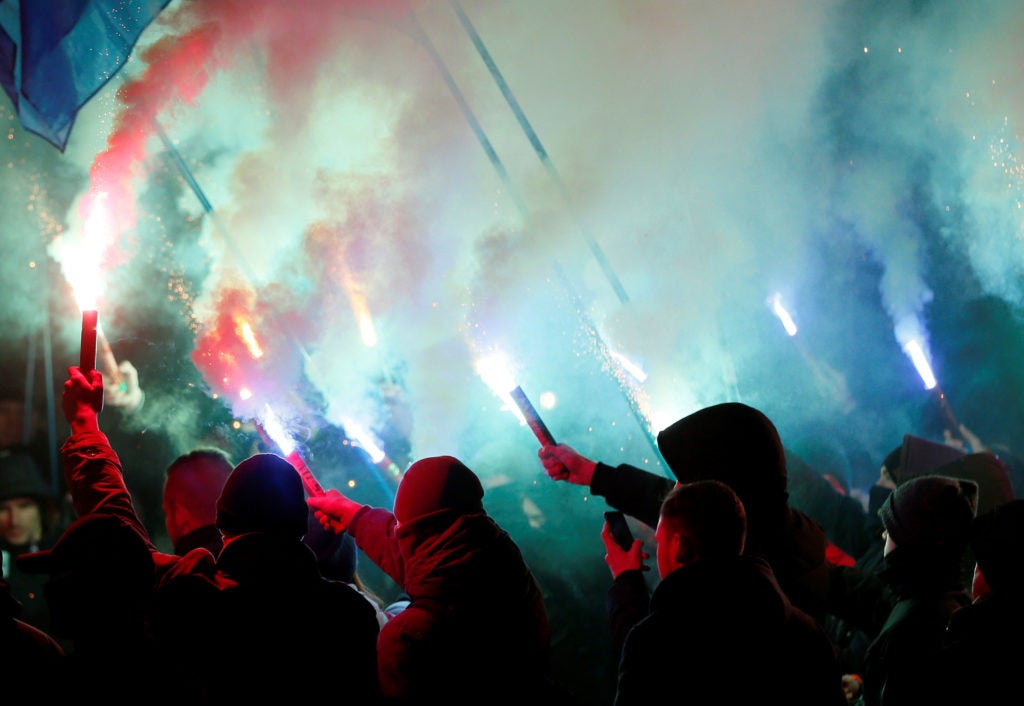
Activists of opposition parties burn flares during a rally demanding to break an agreement with Russia on the use of the Sea of Azov and the Kerch Strait in front of the parliament building in Kyiv, Ukraine, Nov. 26, 2018. (Photo: Gleb Garanich/Reuters/Newscom)
“We are not ready for the war with Russia at sea, even in proactive and asymmetric way,” said Ryzhenko, the Ukrainian navy deputy chief of staff.
Beyond Ukraine, the war’s fallout has reshaped the balance of power in Eastern Europe since 2014, spurring countries across the region to rapidly militarize to defend themselves against the contemporary Russian threat. And when it comes to Russia’s ongoing, multi-domain conflict against the West—all roads lead back to Ukraine.
“In many ways, the future viability of the transatlantic community will be decided in eastern Ukraine in the trenches of the Donbas or on the waters of the Azov,” said Luke Coffey, director of The Heritage Foundation’s Douglas and Sarah Allison Center for Foreign Policy.
“This is why the most recent incident in the Kerch Strait should be so alarming to the U.S. and its European allies,” Coffey said.

